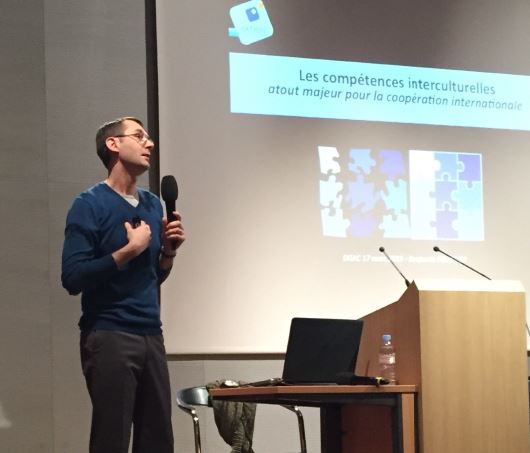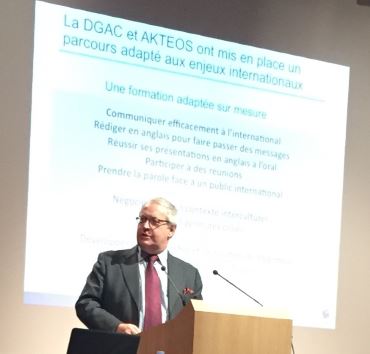Developing intercultural skills
Developing intercultural skills has become a major asset for international cooperation at the Directorate General of Civil Aviation, which organized this conference to raise awareness among its employees.

A DGAC initiative
Odile Grisaud, head of the training office at the Directorate General of Civil Aviation, who initiated this conference, explains:
“The DGAC is by nature oriented towards multilateral cooperation: global civil aviation rules are formulated in liaison with all ICAO member states, and those which concern Europe more specifically are discussed with all European countries . Aviation (air transport) is international in nature.
The DGAC's challenges therefore clearly lie in taking French positions into account in an intercultural context.
Given the number of experts working in Europe and internationally, it is necessary to strengthen the know-how and interpersonal skills of these experts, who all have in common being excellent engineers but who are very aware also the importance of relationships to better communicate with people from different cultures. »
Conference by Benjamin Pelletier

In a context of internationalization of companies and teams, Benjamin Pelletier, intercultural management consultant, has drawn up for the DGAC an overview of the different professional issues linked to intercultural relations in a context of international cooperation. If they are not taken into account, they can lead to the failure of any cooperation, through misunderstandings and erroneous interpretations of different behaviors.
Globalization and new cultural interactions
Take cultural codes into account
When globalization creates new cultural interactions, it is also a reflection of intercultural difficulties. Laughable or disturbing, these can have negative consequences on the perception of the people, teams, companies or cultures concerned.
So when Ségolène Royal went to China in 2007, she was dressed in white and could not imagine the effect it had on the Chinese. Far from being trivial, this clothing detail has created a negative image and a misleading perception. Indeed, in China the color white represents mourning, in the same way as black in France, and this perception is accentuated by a strong superstitious tendency among the population. The perception of a detail or behavior is therefore dictated by the cultural prism through which it is interpreted.
Cultural codes, body language, superstitions, beliefs and religion are cultural elements that define our perceptions and representations. It is also essential to know yourself and to know your own cultural dimensions and patterns of interpretation. This makes it easier to put oneself in the place of the other, to understand their reasoning, their cultural tendencies and therefore their interpretations.
New interactions
In our current global environment, intercultural issues are growing. With globalization, Westerners and North Americans have often thought that the world was one-way and that their cultural model, especially professional, was to be imposed and applied elsewhere. But over the past few decades, new interactions have emerged. For example, Brazil-Africa cooperation demonstrates a “de-Westernization” of the world. “Developed” countries are no longer the only ones to trade with the rest of the world. They in turn must adapt to their foreign interlocutors. The best example is that of China, which has implemented certain technical and health standards different from those of Western countries which must respect them to enter the Chinese market.
“Repatriation” movements
Emerging issues are also emerging and have a strong impact on intercultural issues. “Repatriation” movements are much more frequent. Yesterday, highly qualified talents were expatriated because there were no environments at home conducive to innovation and creation. Today, opportunities exist and the maturity of companies gives rise to a movement of “repatriation”.
New forms of expatriation
New forms of expatriation are also appearing. Today, expatriates no longer position themselves in the host country as “superior”, with a salary higher than the local average, isolating themselves in a very comfortable sphere without any form of adaptation to the local culture. They sign more “local” contracts to carry out equal partnerships. This is also one of the key success factors.
3 conditions for good management of intercultural relations
There is no scientific truth in the intercultural field; we talk more about trends, but nothing is ever fixed when it comes to humans. Three conditions are necessary in the management of intercultural relations:
- Cultural humility
- Cultural expertise, namely the collection of cultural information for a specific objective
- Intercultural competence
Deciphering intercultural relations through key dimensions
In order to understand the broad outlines of a culture, cultural dimensions make it possible to account for the different interactions and perceptions between cultures.
What is the place of individualism versus collectivism within a culture? How is hierarchical distance considered? Is the communication more explicit or more implicit? These examples of questions are raised through the study of cultural dimensions*.
Indeed, depending on the culture with which we are interacting, we must avoid being too direct, take into account posture, gestures, and context, to be understood and to understand our interlocutor. Discomfort can very quickly arise from a detail without even being aware of it. To ensure effective communication exchanges it is important to:
- develop the art of observation without judging
- understand and adjust: collect cultural information by controlling the expression of the negative
- focus on the long term in the relationship and explain its cultural context to foreign partners
From intercultural management to intercultural influence
“A leader is a person whose ideas and actions influence the thinking and behavior of others. Through the use of example and persuasion, as well as understanding the objectives and desires of the group, the leader becomes a lever of influence and change” ICAO, Human Factors Guidelines for Safety Audits Manua, 2002 .
However, being a leader in a multicultural context cannot be improvised. Being aware of the existence of cultural differences is a first step towards understanding other cultures. In a context of international cooperation, mastering cultural influence requires understanding the intrinsic mode of operation of culture and its individuals and becoming aware of intercultural differences.
A significant example: Samsung in Brazil
The example of the successful establishment of Samsung in Brazil is convincing. The Koreans started from the observation that they did not know Brazilian culture. Showing humility by taking this aspect into account was one of the conditions for successful intercultural interactions.
Samsung sent a group of managers to Brazil so that they could immerse themselves in Brazilian culture, discover it, make contact and build a network to create emotional ties with potential future partners. A year later, they had all the cultural information they needed to enter the Brazilian market efficiently. Korean managers were therefore able to exert influence in the host country thanks to understanding and adapting to the local culture. By having integrated the intrinsic mode of operation of Brazilian contacts, they were able to convey their messages and make themselves understood.
We could summarize their approach as follows:
- Humility: being aware of cultural differences to ask the right questions and better understand another culture
- Long-term projection
- Use of the resources of Korean collectivism
- Influence: conditioning a situation to one's advantage
Thus, after immersing themselves in the local culture, Korean managers were able to manage a Brazilian team in favorable conditions to achieve their objectives.
Intercultural influence: 4 principles
The essential conditions for influence in international cooperation are therefore based on four principles:
- Indirect action far upstream
- Continuous and long term
- Ability to argue and seduce
- Intercultural skills
The challenge is therefore to know how to adapt your influence strategy to your playing field. Humility, field analysis and identification of strong and weak points, cooperation and exchanges allow us to better graft our strategy to the culture of our interlocutors.
Intercultural skills and international cooperation

It must be kept in mind that the cultural dimension in exchanges plays a major role. Benjamin Pelletier was able to brilliantly highlight that innocuous gestures or behaviors in certain cultures can be interpreted differently with another cultural prism and lead to misunderstandings, or even the failure of cooperation.
Humility is the watchword for approaching a culture and understanding it; judgments are counterproductive. Understanding others and adapting make it possible to achieve successful cooperation. To achieve this, total immersion in the culture, field analysis, good understanding and cultural adaptation are necessary.
Intercultural management which takes cultural specificities into account is one of the key factors for the success of international cooperation.

